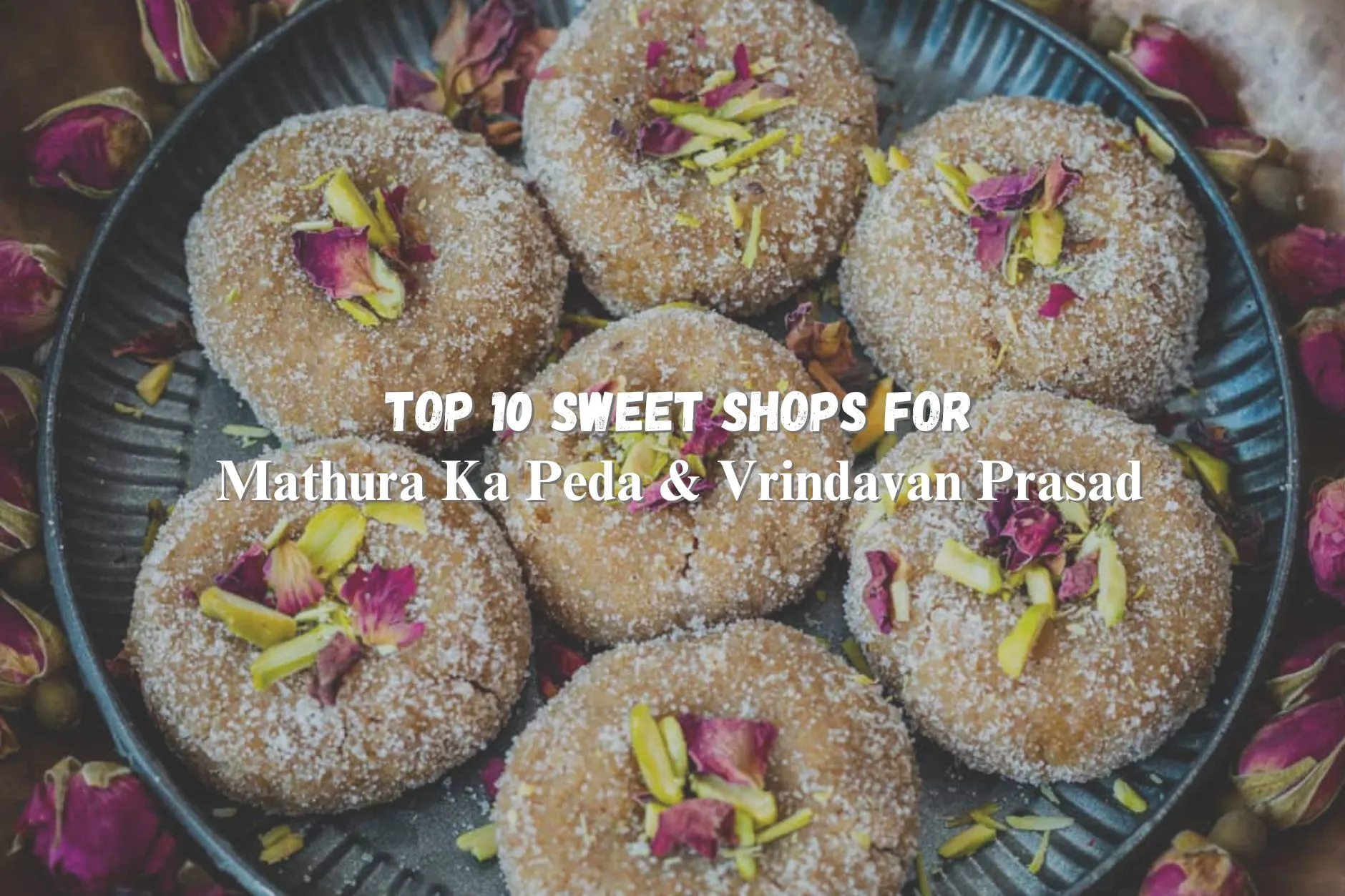Braj is a feeling that long precedes it as a place. The first hint is sound—the temple bells, the swirl of kirtan, the easy “Radhe Radhe” passing between strangers.
The second is scent—agarbatti, ghee, and that unmistakable aroma of milk slowly turning into gold in a heavy iron kadai.
That last one is the calling card of Mathura ka Peda, one of India’s most storied sweets. Pair it with the quiet grace of Vrindavan prasad, and you have the taste of Braj itself.
Our drivers hear the same question again and again: “Which shop has the real Mathura peda?” and “Where do we get pure Vrindavan prasad?”
Below, you’ll find the answers we give our own families, shaped by decades of lived experience in Mathura, Vrindavan, Govardhan, and across Braj.
“In Braj, sweets are not a dessert at the end of a meal; they are the first language of devotion.”
What Makes Mathura Ka Peda Different (So You Don’t Settle for Imitations)
True Mathura pedas are not mass-manufactured; they are made. Real khoya is reduced patiently, then coaxingly transformed into something denser, darker, and gently grainy, like cream and custard.
The color becomes a natural toffee brown; the fragrance is roasted milk, never perfumed; the sweetness rounds off instead of spiking.
Most telling of all: warm pedas. A fresh batch doesn’t need a sales pitch—its aroma will find you in the lane.
Five quick authenticity checks:
- Natural brown, never artificially bright.
- Roasted-milk aroma (khoya first, sugar second).
- Soft-grainy bite—no rubbery spring, no syrupy gloss.
- Sweetness that lingers without sticking to your throat.
- Warmth and moisture from the kadai, not from syrup.
Why Vrindavan Prasad Tastes “Blessed”
Prasad in Vrindavan is food first offered, then shared. That one act changes how it’s made and how it’s received. Ghee laddoos, makhan-mishri, tulsi-kissed offerings—each keeps ingredients simple and intentions clear.
Purity matters more than novelty. When travelers ask why even a small laddoo feels so satisfying, we say: Because it’s prasadam; you don’t measure it only with the tongue.
“In Vrindavan, the recipe is short and the method is long—purity takes time.”
Top 10 Sweet Shops for Mathura Peda & Vrindavan Prasad
This list focuses on authenticity, fresh turnover, and consistent quality. Batch timing changes with seasons and crowds—Mathura Taxi Service drivers can help you hit the right shop at the right hour.
1) Brijwasi Mithai Wala, Mathura
A long-trusted name that still values method over marketing. Pedas are roasted to a deep, honest brown with a satin-matte finish and an aroma that tells you the batch was recent.
- Order cue: Ask when the last peda was taken out of the kadai; aim for mid-morning or late afternoon.
- What to try: Classic Mathura peda; khurchan for a contrast in texture.
2) Shreeji Peda Bhandar, Jama Masjid Road, Mathura
Old-school bhatti heat, slower roasting, and a slightly darker hue. This is the peda you remember later on a train, wondering if you should have bought a kilo more.
- Order cue: Avoid closing time scraps; go when they’re actively forming pedas.
- What to try: Deep-brown roasted pedas; pure ghee laddoos.
3) Radhika Sweets, Near Shri Krishna Janmabhoomi
Built around pilgrim turnover, with frequent small batches and a softer, lighter color profile. Ideal for those who prefer a gentler sweetness and a melt-softer texture.
- Order cue: “Fresh abhi-abhi nikla”—that’s your signal.
- What to try: Fresh white peda; doodh laddoo.
4) Braj Rasoi Peda Wala, Holi Gate, Mathura
Crowded, aromatic, and confident about freshness. Pedas are warm, pliant, and never glossy. Their small prasad laddoos travel well.
- Order cue: Morning purchases beat the evening rush for a peaceful tasting experience.
- What to try: Standard khoya peda; makhan-mishri packs.
5) Banke Bihari Prasad Counters, Vrindavan
Not a commercial sweet shop—authorized counters handling prasad associated with Banke Bihari Ji. Buy here when what you want is offered first and shared later.
- Order cue: Align with darshan/aarti; turnover is fastest right after.
- What to try: Temple laddoo prasad; makhan-mishri; tulsi-touched portions.
6) Prem Mandir Prasad Counter, Vrindavan
Consistency, cleanliness, and care. The laddoos are honest: fragrant, firm without being hard, and never oily—a reliable treat for elders to take home.
- Order cue: Evening is magical; combine lights, darshan, and prasad.
- What to try: Ghee laddoo; nariyal prasad on special days.
7) Gopaljee Sweets, Vrindavan
A modern, transparent counter with traditional flavors intact. Pedas here skew a little softer, but keep the khoya soul.
- Order cue: Confirm batch times; mornings are your friend.
- What to try: Vrindavan-style peda; kesar laddoo when available.
8) Govardhan Peda Wala, Parikrama Route, Govardhan
If you’re walking Parikrama, this is your midpoint treat. There’s a faint smokiness from old-fashioned heat that’s impossible to fake.
- Order cue: Don’t overload if you still have kilometers to walk.
- What to try: Govardhan Peda; simple Parikrama Prasad packets.
9) Radha Kund Sweet Shops Cluster, Near Radha Kund
A handful of compact shops that keep sattvik standards and move stock quickly in the mornings. Many devotees buy here to offer at Radha Kund first.
- Order cue: Mornings for freshness; buy small, taste, then pack.
- What to try: Pale-brown or white pedas; tulsi laddoos.
10) Nathji Peda Wala, Vrindavan Market Lanes
A modest local favorite with a loyal crowd. The pedas are classic: grainy, gently caramel, unshowy—easy to eat two without thinking.
- Order cue: Ask for the batch that “just cooled.”
- What to try: Roasted mawa peda; a small box for tea later.
Side-by-Side Comparison (Quick Planner)
| Brijwasi, Mathura | Classic brown peda | Mid-morning, late afternoon | Roasted, rounded sweetness | Ask for kadai-fresh; avoid last-hour boxes |
| Shreeji, Jama Masjid Rd | Deep-roast peda | Late morning | Caramel-forward, slightly firmer | Traditional bhatti feel—worth the wait |
| Radhika, near Janmabhoomi | Fresh white peda | Any time with “just made” batches | Gentle, milky, softer | Ideal right after temple darshan |
| Braj Rasoi, Holi Gate | Warm khoya peda | Morning | Soft, pliant, satin-matte | Buy first, taste, then decide bulk |
| Banke Bihari counters | Laddoo prasad, makhan-mishri | Post-aarti | Simple, sacred, balanced | Official counters only—ask our driver to point them out |
| Prem Mandir counters | Ghee laddoo, nariyal prasad | Evening | Clean, fragrant, not oily | Perfect take-home for elders |
| Gopaljee, Vrindavan | Vrindavan-style peda | Morning | Softer, balanced | Hygienic prep; good for families |
| Govardhan route shop | Govardhan peda | Mid-route pause | Light smokiness, hearty | Keep it light if walking long |
| Radha Kund cluster | Sattvik peda, tulsi laddoo | Morning | Pure, mild | Offer first if that’s your practice |
| Nathji, Vrindavan lanes | Roasted mawa peda | Hygienic prep; suitable for families | Classic, grainy | Small shop, big heart—ask, don’t rush |
A Food-First Half-Day Itinerary (Designed by Mathura Taxi Service)
- 08:30 – Pick-up in Mathura. Warm-up taste at a Janmabhoomi-side shop (gentle, milky peda).
- 09:30 – Head to Holi Gate for a kadai-fresh, roasted batch (compare textures).
- 11:15 – Drive to Vrindavan. Collect the official Banke Bihari Prasad after darshan.
- 12:30 – Early lunch; pause for palate rest.
- 18:30 – Stroll around Prem Mandir by the lights; buy evening ghee laddoos to take home.
- 20:00 – Drop. Boxes packed to travel, stories packed to remember.
With Mathura Taxi Service, drivers call ahead to check batch times, steer you to authentic counters, and keep the day unhurried and on schedule.
“Good peda isn’t fast food. Waiting is part of the recipe.”
Buying, Storing, and Traveling With Sweets (So They Taste Great at Home)
- Portion first, bulk later: Start with 250g from two shops, pick your winner, and then buy 1–2 kg.
- Paper inside the box: Ask for butter paper or parchment lining—prevents sweating.
- Room-temp rules: In winter, 48–72 hours is fine. In summer, finish within 24–36 hours.
- If you must refrigerate, ensure it’s in an airtight container. Bring to room temperature before serving.
- Flights and trains: Hand-carry sweets. Keep boxes flat; avoid soft, syrup-leaning sweets in peak heat.
Seasonal Smartness (2026 Focus)
- Winter (Oct–Feb): Best textures and most extended freshness. Great time to gift.
- Holi (Feb–Mar 2026): High turnover means peak freshness but larger crowds—plan slots.
- Janmashtami (Aug 2026): Special prasad, festive energy, quick sell-outs—buy earlier in the day.
- Monsoon (Jul–Sep): Lovely aromas in shops; pedas skew softer—taste before bulk purchase.
- Peak summer (Apr–Jun): Buy fresh and eat the same day; choose firmer, more deeply roasted pedas.
Hygiene & Ethics (Our Standards)
We measure a shop by three key signs: clean counters, visible batch work, and a patient queue. We avoid syrup-glazed sheen and synthetic scents.
We never pressure vendors during aarti rush, and we always carry our wrappers until we find a bin. Every Mathura Taxi Service route follows the same code—we want future pilgrims to taste Braj at its best, too.
Why This Guide—and Why With Mathura Taxi Service
We know which counter turns stock quickly after Aarti, which lane smells right at 10:45 a.m., which vendor learned from his father, and which day you should come back for the special batch.
More than just transport, we provide taste logistics—the timing, the turns, and the small decisions that make the difference between a good box and one you remember years later. That’s why travelers return to Braj with us, and that’s why this guide has your name on it.
Book Your Sweet-Trail & Darshan Day
Mathura Taxi Service
- Email: mathurataxiservice@gmail.com
- Phone/WhatsApp: +91 9634616363
- Website: https://mathurataxiservice.com/
Tell us about your temple priorities and dietary preferences; we’ll create a safe and comfortable route that respects darshan timings and lands you at the right counters while the pedas are still warm.
“Come hungry for devotion—and save a little hunger for dessert. Braj will take care of both.”
FAQs
1. Which shop is the most famous for Mathura ka Peda?
The most famous shops are located around the Shri Krishna Janmabhoomi Temple and Dwarkadhish Temple markets. These areas serve freshly prepared, traditional pedas made from slow-cooked khoya.
2. What makes Mathura ka Peda taste so different?
Mathura ka Peda is slow-roasted for hours, resulting in a caramelized brown color, a grainy texture, and a rich aroma. The unique taste comes from pure khoya and age-old preparation techniques.
3. Where can I find the freshest peda in Mathura?
Fresh batches are usually available early in the morning and in the evenings at shops located near Janmabhoomi Road, Holi Gate Market, and the Dwarkadhish Temple area.
4. Which shops offer authentic Vrindavan prasad?
Vrindavan prasad is primarily available at temple prasad counters, especially at the Banke Bihari Temple and ISKCON Vrindavan. These are freshly prepared and served throughout the day.
5. What is the best time to buy Mathura ka Peda for freshness?
The best times are early morning, when shops prepare the first fresh batch, and evening around aarti time, when demand is high and pedas are quickly sold.
6. Is Vrindavan prasad available in small packets for tourists?
Yes, most temples offer neatly packed prasad packets—laddus, mishri, makhan, and pedas—ideal for taking home or gifting.
7. Can I buy Mathura ka Peda online?
Some sweet shops offer home delivery or courier packaging, but for the most authentic taste, it is recommended to buy directly in Mathura due to the freshness.
8. Which sweet shops are most popular among locals in Mathura?
Locals prefer traditional shops around Janmabhoomi Road and Chowk Bazaar due to their consistent quality and handcrafted pedas.
9. What type of prasad is Vrindavan most known for?
Vrindavan is famous for Banke Bihari Temple Prasad, laddu prasad, makhan-mishri, tulsi prasad, and special pedas made for temple offerings.
10. How much does Mathura ka Peda usually cost?
The price usually ranges between ₹300 and ₹800 per kilogram, depending on the quality, purity of ingredients, and the shop’s reputation.





Leave a Reply